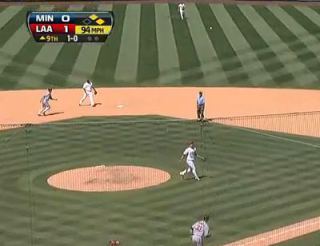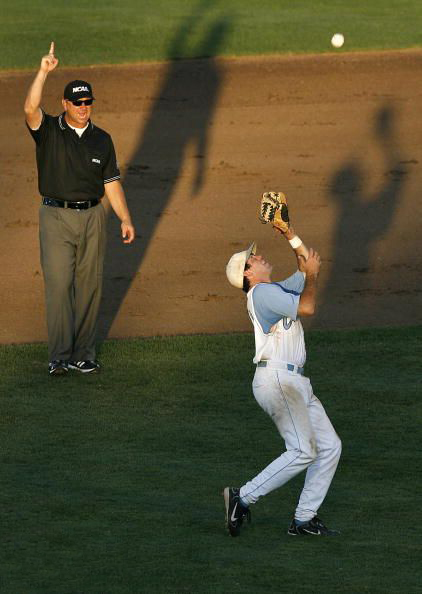Hello and welcome to Umpires Call. Here I will be addressing some interesting parts of life as an umpire in British Baseball and some of the rules to our game.
Let’s start with the frequently misunderstood ‘Infield Fly Rule’ (the IFR). Here are the key things to remember:
- The Infield Fly Rule applies when there are runners on 1st and 2nd bases, or the bases are loaded, AND, there are no outs or only one out, AND the batter hits an ‘infield’ pop-up (see below).
- It is an UMPIRE’S judgment call, and he must call it immediately.
- When called, the batter is out, and the runners on bases are no longer in forced-out situations. BUT, the ball is STILL LIVE, and the runners may advance, but now at their own risk of being tagged out.
- The definition of what is ‘infield’ is in the umpire’s judgment. The IFR applies if an infielder moves into the shallow outfield to catch — in the umpire’s judgment — an easily catchable pop-up; OR if an outfielder runs into the infield (thus becoming an infielder) to try to catch an infield pop-up easily catchable.

Why is there an Infield Fly Rule?
- You know that with a runner behind you, you must must run, either because that runner is also forced by a runner behind him, or because you’re on 1st base and the batter-runner is forcing you to 2nd base.
- So, an infielder could deliberately not catch an infield fly, either deliberately dropping it (fumbling the catch), or just letting it drop to the ground next to him/her. The runners on 1st and 2nd (or on 1st, 2nd and 3rd) would all be waiting to tag up on a fly ball, right? By deliberately ‘missing’ the catch, the infielder could then make an easy double play by throwing to the base of the most advanced runner (who is forced), and that baseman throwing to the next base behind, the runner to which is also forced, thus getting the double play (in fact, the first throw can be to any base other than 1st, or to Home if the bases are loaded). This is unfair with the forced runners waiting on their bases for tagging up — and that’s why the IFR was made.
- Therefore, it is the umpire’s judgment that the pop-up hit is within what is defined as the infield and that it is a reasonably easy catch for the infielder. (This could even be a quite ‘deep’ pop-up that a shortstop could easily catch, even though it appears to be into the outfield — it is the umpire’s call.)
So, you are probably thinking: Why doesn’t the IFR apply with only a runner on 1st base (and no outs or one out)? After all, the runner on 1st is forced to 2nd by the batter-runner, creating an ‘easy’ double play for the defensive infield.
The reasons are these:
- Any batter who hits the ball will run as fast as he can to 1st base — no hesitation; he’s got no place else to go.
- Even though the runner on 1st base will hesitate, needing to tag up on a fly ball …
- … if the infielder deliberately fumbles the catch, then throws to 2nd base to get the forced runner out, it is highly unlikely that there will also be enough time to get the batter-runner at 1st base, who will most likely already be there by the time the fielder has retrieved he ball and the runner has been thrown out at 2nd base — the batter-runner has no thoughts about tagging up, as he’s only got to run to 1st base.
- Also, with no outs or one out, there is little difference to the defensive team about an out on 2nd on the forced runner, or an out of the batter-runner on 1st base, also a forced out. Either way they get another out. BUT SEE BELOW.
Further, with a runner only on 1st base, of course the umpire will not be anticipating the potential call of an IFR because he knows it does not apply in that situation.
 And there is also a rule that a defensive player cannot deliberately drop or fumble a catchable fly or line-drive ball — in the umpire’s judgment — with the intention of turning a double play. The umpire would call that, in which case the batter is out and the BALL IS DEAD (so, unlike the IFR situation, the runners go nowhere).
And there is also a rule that a defensive player cannot deliberately drop or fumble a catchable fly or line-drive ball — in the umpire’s judgment — with the intention of turning a double play. The umpire would call that, in which case the batter is out and the BALL IS DEAD (so, unlike the IFR situation, the runners go nowhere).
HOWEVER, the above applies to a deliberately fumbled catch.
An alert infielder, with only a runner on 1st base, may deliberately not catch an infield pop-up to get a potential double play, IF he lets the ball drop to the ground WITHOUT TOUCHING IT. Remember, the batter is running all out for 1st base, so that astute infielder is trying to get out the LEAD runner, so he would want to throw out the runner heading for 2nd base, who would be hesitating at 1st for his tag-up and/or to stay safe at 1st expecting the fly ball to be caught. Deliberately fumbling a catch (appearing to make the catch but then deliberately dropping it) is unfair deception and would be called as such by the umpire. By legally letting the ball fall directly to the ground, however, this infielder is taking a risk, because the ball might bounce out of his reach and give him no chance of getting either runner out, but that’s his decision.
I hope you found this helpful and informative. There is more to come from The Doc in Umpire’s Call soon




No comments yet.